Paleolithic decorative art can be classified in three subgroups:
- art applied to tools embellishment,
- decorative art of the person (necklaces, pendants, etc.),
-decoration of "not utilitarian manufacts", of which the use is not known.
The decorated objects found in the second half of the 20th century originate almost all from excavations, and therefore have a cultural attribution, and are dated.
Embellished tools belong to Acheulean, Solutrean and Magdalenian .
The most beautiful tools are the Magdalenian propellers, which are authentic sculptures, and veritable art works.
There are no embellished tools in Mousterian, Aurignacian, Gravettian and Azilian.
The only ornamental object, that is common to these six civilizations, from Mousterian to Azilian, is the pierced tooth, used for necklaces. All the pierced teeth are of animals.
ACHEULEAN LITHIC INDUSTRIES
Acheulean lithic industries typology is much diversified, and consists of amygdales and tools on flake, that were used for cutting, scraping, etc.
Biface is a multipurpose tool, but its exact use is unknown. In the 1800s it was referred to as a "hand axe."
Several authors in the last 50 years have found that ." the Acheulean amygdales are more beautiful than is necessary .".
To the contrary the lithic tools used for cutting, scraping, etc., and not only those of the Acheulean, but of the entire Paleolithic, are strictly functional and have no embellishment. This is verified also in tools of the historical times; as an example a sword or a dagger have embellished the handle, while knives of a butcher or a shoemaker, are strictly functional, without embellishments.
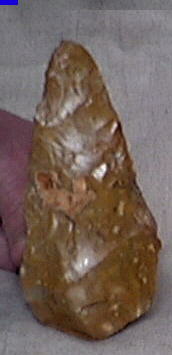

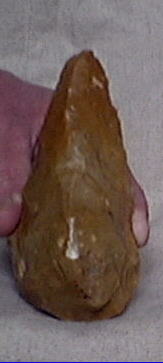
Acheulean Biface
Silex, height cm 12, widht. cm 6, thickness cm 5, weight kg 0.250.
Origin Rodi Garganico ( Foggia, Italy)
According to the classification by G.Camps (1979), I can attribute it to the thick amygdales, type B5 micoquien.
This amygdale in my interpretation is zoomorphic, and depicts a bird's head with a long beak.
The photographs and the drawing are disposed in vertical position as in use for the amygdales, but in the following photos (Fig. 18, 19, 20, 21, 22) the amygdale is in horizontal position to better see the head of the bird in natural position.
Fig. 1
View of the flat side of the amygdale, corresponding to the lower surface in the bird's head view position (see: Figg. 18, 19, 20, 21, 22)
Fig. 16
Drawing of the lateral view. The sharp part is the one pointed, measuring less than one-half the length of amygdale.
Fig. 17
View of the back of the flat side, which is totally relief, and constitutes in the horizontal view the head of the bird with the long beak.
THE AMYGDALE
In palethnology the word "amygdale" has been just replaced from " bi-faced handaxes ", but I continue to use the terminology amygdale because I like it better.
The shape of the amygdalae is variable. G. Camps (1979) has classified 19 types. Everyone of these types has different traditions in the immensity of time of the Acheulean, and in the immensity of the geographic distribution.
Drawings of these amygdales are shown in the recent book by Prof. Alberto Broglio " Introduction to Paleolithic " (Laterza, Rome - Bari, 1998). In this book is accurately described also all the art applied to the tools and the ornamental objects in bone and ivory of the upper Paleolithic, found in the diggings, with accurate description of the cultural context, and with the datings. It is an recommend work for all the Paleolithic.
THE AMYGDALE INTERPRETED AS WEAPON
The hypothesis that I do about the amygdale interpreted like a weapon is founded on the consideration that it was carried in the travels that the man daily made, and therefore embellished.
As weapon, it could be used as an auxiliary tool to wooden spears in hunting large mammals.
At Ambrona, in Spain, about fifty elephants were killed and quartered on place, and the deposit has given a good number of amygdales,some "hachereaux" on flake, as well as other tools on chip.
At Torralba, near Ambrona, in the deposit with remains of elephants, several wood fragments worked in the Acheulean were found, which probably were part of the hunting equipment.
There is to be asked as they made, without amygdales, the men of other civilizations, like the Clactonian one, in other zones of the planet, since they hunted the same animals; but probably they had substitutive tools of wood.
The origin of the amygdale is in the Oldowan "chopping-tool", of which probably, also after several hundreds of thousands of years, has conserved, at least in part, the original use.
With the end of the Acheulean the amygdala is disused, that is the man does not produce it longer.
The amygdala, meant as travel weapon, can be assumed at the origin of the dagger, at least for the pointed types, in how much it could be used for defense and for attack. This possible use has always been a necessity, that is checked in some periods, and not in others of the life of the man.
THE ART APPLIED TO THE EMBELLISHMENT OF THE AMYGDALE
I am convinced that the amygdale was an instrument of prestige, and therefore embellished; however, the embellishment was not deprivation of the functionality proper of the use for which it was produced.
The 19 types of amygdales, by G. Camps classified, testify the variety of styles that was present in the planet during the Acheulean.
The shape of the amygdale is style, that is the language of the embellishment in art.
As an example, if we examine 19 jugs in terracotta of the same size, of different civilizations of the ancient Mediterranean, not taking into consideration the painted or colored surface, we see that they have 19 different shapes, that is different style, but the function is the same, that is to contain water.
Near some of these civilizations have been made also pitchers in terracotta with the shape of the human head, and with the shape of head of animals.
In the Acheulean there are amygdales having the shape of human head (Fig.3, 4, 6, 7, 9, 10, 12, 13), and shaped as head of animal.
Anthropomorphic amygdales are of two types. One type represents two human heads with look in opposite direction, the other type a single human head.
Anthropomorphic amygdales, according to my attribution, that can be found in Camps' classification are as follows :
A. Flat bi-faced handaxes
-- 3) subtriangular (Fig.2)
-- 4) heart-shaped (Fig.5)
in these types the dimension of the heads, from bottom to top, takes up about 2/3 of the height
B Thick bi-faced handaxes
-- 4) lanceolate (Fig.8)
--5) micoquien (Fig.11)
in these types the size of the heads, from bottom to top, takes up approximately 1/3 of the height.
In the classification by Camps there are other two types that probably derive from the amygdales A3 and A4, in which the anthropomorphic representation is abandoned, but the general structure remains and they are the following :
A.Flat bi-faced handaxes
-- 1) triangular (Fig.14)
-- 2) triangular lengthened (Fig.15)
This is a hypothesis, which requires in-depth verification.

Fig.2 Acheulean amygdale
By G. Camps (1979), it has been classified between the flat bi-faced handaxes : type A3 subtriangular.
Fig. 3 simulation of bi-faced anthropomorphic amygdale.
Fig. 4 Simulation of anthropomorphic amygdale.
(Fig. 3 and Fig. 4: in these two types the head take approximately 2/3 of the height. Drawings represent the profile of the head that is in the cutting part of the amygdale. The eyes and the mouth do not exist in the amygdale, as the working technique is of removal of the flakes, but they have been drawn as identification sign. The search for this type of amygdales should be directed to the subtriangular type A3 , Fig. 2)
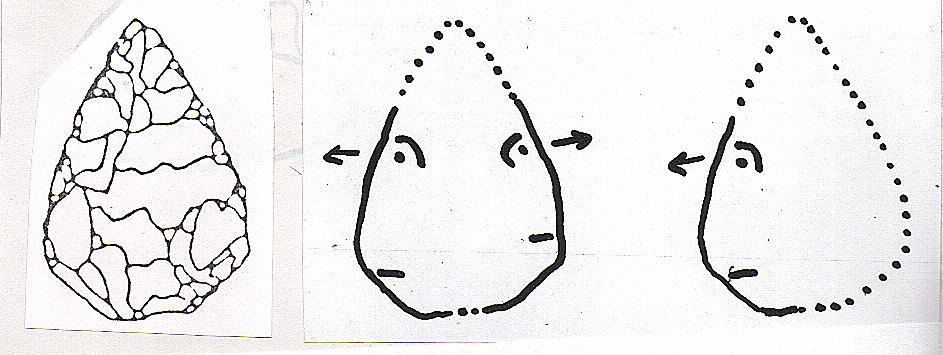
Fig. 5 Acheulean amygdale
By G. Camps (1979), it has been classified between the flat bi-faced handhaxes: heart-shaped type A4.
Fig. 6 Simulation of anthropomorphic amygdale bi-faced .
Fig. 7 Simulation of anthropomorphic amygdale.
( Fig. 6 and Fig. 7: in these two types the heads take approximately 2/3 of the height. The drawings represent the profile of the head that is in the cutting part of the amygdale. The eyes and the mouth do not exist in the amygdale, in how much the working technique is of removal of the flakes, but they have been drawn as indication for the location. The search of this type of amygdales must be addressed on the heart-shaped type A4, Fig. 5).
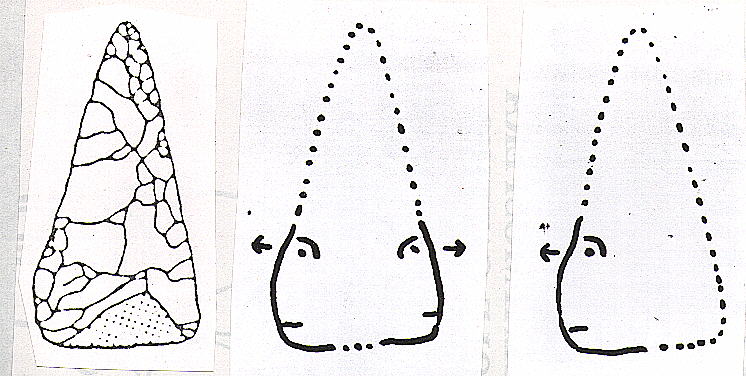
Fig. 8 Acheulean amygdale
By G.Camps (1979), it has been classified between the thick bi-faced: lanceoled type B4.
Fig. 9 Simulation of anthropomorphic amygdale bi-faced .
Fig. 10 Simulation of anthropomorphic amygdale.
( Fig. 9 and Fig. 10: in these two types the heads take approximately 1/3 of the height. The drawings represent the profile of the head that is in the cutting part of the amygdale. The eyes and the mouth do not exist in the amygdale, in how much the working technique is of removal of the flakes, but they have been drawn like indication for the location. The search of this type of amygdales must be addressed on the lanceoled type B4, Fig. 8).
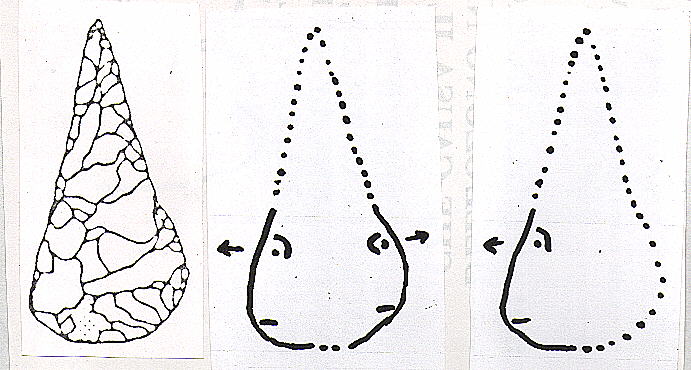
Fig. 11 Acheulean amygdale
By G. Camps (1979) it has been classified between the thick bi-faced: micoquien type B5.
In this typology, as in others classified by Camps, can be found in addition to anthropomorphic representations, also zoomorphic representations.
Fig. 12 Simulation of anthropomorphic amygdale bi-faced.
Fig. 13 Simulation of anthropomorphic amygdale.
(Fig.12 and Fig. 13: in these two types the heads take approximately 1/3 of the height. Drawings represent the profile of the head that is in the cutting part of the amygdale. The eyes and the mouth do not exist in the amygdale, in how much the working technique is of removal of the flakes, but they have been drawn like indication for the location. The search of this type of amygdale must be addressed on the micoquien type B5, Fig. 11)
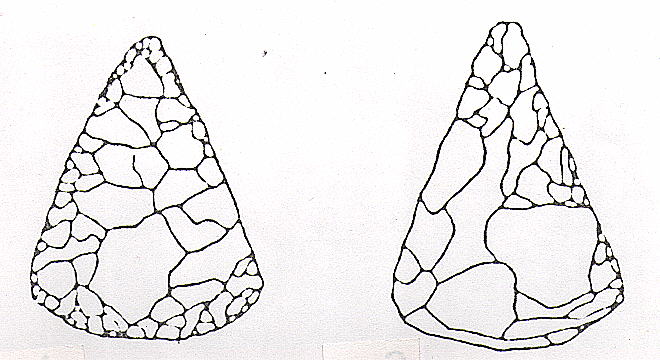
Acheulean amygdales
By G. Camps (1979), they have been classified between the flat bi-faced handhaxes:
Fig. 14 type A1 triangular
Fig. 15 Type A2 triangular lengthened
(the flat bi-faced handhaxes and the thick bi-faced re-enter in two different cultural traditions. It is hypothesized that these two types of amygdales could derive from the anthropomorphic amygdales, in a hypothetical phase of end of the anthropomorphic representation, almost certainly connected to rituals of cult. These two amygdales are here published, like clue not to neglect in the research for identify the transformation process, if any).
The concept of beauty of the shape, in our judgment, is based also on aesthetic appraisals, with parallels to other merely functional tools that have no embellishment.
Beauty is (and was) in the processing of the shape, that in part is due to the functionality, and in part to aesthetic factors.
As for anthropomorphic and zoomorphic amygdales, the depiction can be more or less realistic; that doesn't mean more or less beautiful, however, anthropomorphic and zoomorphic amygdales I've seen all have a good standard of quality.
It is necessary to consider that in the amygdales the representation of every human head relates only the lateral profile of the head, from the forehead to the anterior part of the jaw; while in the amygdales type A3 and B4 is sometimes evidenced the reentering of the jaw. Above the heads there is the point of the amygdale.
know only one zoomorphic acheulean amygdala, that I have found 20 years ago in the Rodi Garganico hinterland (Prov. Foggia, Italy). It represents a head of bird, similar to the duck.
The types of acheulean amygdales that are not anthropomorphic or zoomorphic are 15, with 15 different shapes, of which the only variation is size, that is, each type can be longer or shorter.
I label as "multiform" these 15 types of amygdales to distinguish them from anthropomorphic and zoomorphic ones.
The embellishment of the multiforms amygdale re-enters totally in the art, since it is the harmonious processing of a shape, and therefore it has many styles.
These styles are better understood in the figurative art, where a human head is made from every people in different way, that is in different style.
The artistic elaboration of the amygdales can be subdivided in figurative and abstract.
In the historical periods (but also in artefacts on bone and ivory of the upper Paleolithic) the abstract art in the decoration of the objects occurs in two aspects :
- elaboration of a harmonious shape
- geometric graphics .
As an example, a terracotta water pitcher may be painted with geometric patterns, and thus there are two styles that fall under abstract.
If the jug is painted with figurative subjects, there is the mixture of an abstract and a figurative style.
As we will see in the following, geometric decorations were produced in the Acheulean with the technique of engraving on bone.
All the amygdales, including anthropomorphic and zoomorphic ones, have geometric structural shapes, which are integrated with the working technique, with the functionality, the main motive of this tool, and with the artistic application.
Amygdales were made of hard stone, and no amygdales are known to have been further embellished with engravings of geometric patterns. .

Fig. 18 Zoomorphic acheulean amygdale
Lenght cm 12, widht cm 6, height cm 5, already seen in vertical position Fig. 1, 16, 17.
It depicts a bird head with long beak. Left side view.
(see drawing Fig. 19).
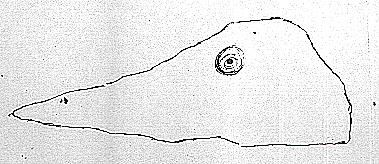
Fig. 19 Zoomorphic acheulean amygdale
It represents a head of bird with long beak.
(drawing of the left lateral view: Fig. 18, with the eye, not existing in the amygdale, but it indicates where it should be imaged to better understand the head of the bird depicted).

Fig. 20 Zoomorphic acheulean amygdale .
It represents a head of bird with long beak.
Right lateral view. (Back of the left lateral view: Fig. 18).
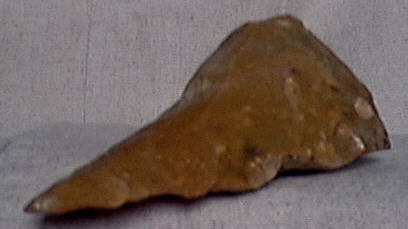
Fig. 21 Zoomorphic acheulean amygdale
It represents a head of bird with long beak.
Semifrontal view.
Fig. 22 Zoomorphic acheulean amygdale
It represents a head of bird with long beak.
Frontal view
(In this photograph you can see the curving of the head of the depicted bird, which corresponds to the largest part of the amygdala handle).
HOW TO IDENTIFY ANTHROPOMORPHIC AND ZOOMORPHIC AMYGDALES
Among Lower Paleolithic stone tools, Acheulean amygdala has perhaps been the most studied.
F. Bordes has suggested to detect for every amygdale a series of measures: maximum length, maximum width, distance between maximum length and base, etc. (see A. Broglio, work cited).
G. Camps has classified 19 types of amygdalae.
The first amygdale was discovered in 1797 by John Frere at Hoxne (Suffolk).
In the hands of the palethnologists in two centuries of research, are passed, probably, tens of thousands of amygdales, which have been studied.
Now, rightfully, the reader will ask himself about the motive for which have not been identified anthropomorphic and zoomorphic amygdales
It is an appropriate question that deserves an answer.
In the 19th century the palethnology was born as science about the study of stone tools, and not about the paleolithic art, which will be discovered decades later, when the study of tools will be already well consolidated. It follows, that has remained a tradition of exclusion of the art in general.
About 40 years ago, a palethnologist told me that the beauty of an amygdale is seen by us, but it was not wanted (by the Acheuleans), because it was a consequence of its functionality. Of course, this was the mentality of that time.
Today after Camps' classifications, the concept of functionality should be called into question. For example, the difference between the amygdala "triangular A1" and that " discoid A9" is abysmal. So, functionality always, but also applied art !
A parallelism can be made about this kind of difficulty with the interpretations of the Upper Paleolithic cave paintings , which, after overcoming the mistrust of fake of the end of the 19th century, have been many. Some interpretations have been recognized by all, and others have not, but by now no one doubts the authenticity of the paintings.
The authenticity of the amygdales cannot be questioned, while the interpretation of the anthropomorphic and zoomorphic amygdales remains..
The great Jacques Boucher de Perthes (1788 - 1868), who saw carved images everywhere, did not investigate anthropomorphic and zoomorphic amygdales, as he had categorized his findings into industries and art; but perhaps, also because, despite the cultural breadth of his insights, mixing industries and art was not logical.
If the palethnologists in the second half of the 20th century have not interpreted the anthropomorphic and zoomorphic amygdales, also having had the possibility, the reasons are at least two: 1°) because they have not set themselves the problem; 2°) probably, because in some is rooted the conviction that the man of the Acheulean cannot give more.
It is not excluded that, still today, there are palethnologists who, when confronted with anthropomorphic and zoomorphic amygdales, deny the evidence, with motivations that I cannot preview.
To face this problem of interpretation, therefore, is a desperate enterprise, but interesting, and then.......science must go on.
I saw some tens of anthropomorphic amygdales, about 25 - 35 years ago, in several small French provincial museums, that displayed many amygdales.
Who wants to become documented and do research, should have access to the laboratories and museums warehouses, because with the new museographic concepts, fewer and fewer artifacts are exhibited.
In Italy, I have visited recently one of the most important museums of prehistory, in which when I was young I had seen in the display windows many amygdales (then I did not imagine that could exist anthropomorphic amygdales), but in the display windows there were not more amygdales, but only a pair of copies.
These copies, I believe, are made in plaster, and then are painted; therefore, you cannot see the traces of workmanship, nor the parts that, possibly, have not been worked; you cannot see the sharp edge, and the amygdale appears rounded. From a copy it is difficult to determine if an amygdala is anthropomorphic or not.
The research can be made also from drawings and photographs that are on the books. .
The drawing, if well done, allows to individualize an anthropomorphic amygdale; however, if the illustrator does not know that it is anthropomorphic, not emphasizes small details, and this decreases the evidence. However, before identifying an anthropomorphic amygdale from a drawing in a palethnology book, it is necessary to have seen at least one, and much better to have had one in hand. .
Detecting in color photograph is easier, but not in all cases.
THE AMYGDALE IN WORSHIP RITUALS
Also the palethnologists have a " heart " tied up to the aesthetic, therefore the finding of an amygdale is always more exciting than when they find small tools on flake; also because these are numerous, while the amygdales are rare. For this, it is reasonable to ask himself why man has stopped to make amygdales, and has not stopped to make the tools on flake that he always has made, and that we find in all the successive civilizations of the Paleolithic.
I believe that in human activities does not exist, strictly speaking, neither an origin nor an end.
I hypothesize that, towards the end of the evolued Acheulean, amygdale began to go in disuse for pure utilitarian purposes, but maintaining its importance in worship rituals. This hypothesis is based on the production of anthropomorphic and zoomorphic amygdales, whose subjects: head of animal, human head and bicephalic human head, are appropriate to the hypothesis of subjects of cult. It is ascertained that the cults last longer than the technique.
On the employment of the amygdales in the ritual, I make a parallelism with the propellers of javelins made from horn of reindeer in the Magdalenian, examining the two more known.One comes from the cave of the Trois Frères (Ariège) and is a very realistic sculpture depicting two ibex fighting with extraordinary energy; the other is the the other is the " fawn with birds ", discovered in 1941 by Saint-Just Péquart in the Mas d' Azil: " a young fawn, pointing itself with force on the four legs, turns the head towards its own back, while with its tail raised, expels from an extraordinarily dilated sphincter a voluminous fece where two little birds are resting&quoy (Furon).
It is difficult for me to imagine that thrusters of such beauty and descriptive strength, were used to go hunting on the so impervious mountains, that are around the area of the caves, and this, also considering the Magdalenians as very refined men.
I am induced to suppose, instead, that these propellers were used for competitions, game, ceremonies, or rituals of cult.
Same supposition applies also for the anthropomorphic and zoomorphic amygdales of the Acheulean, in how much, even if the artistic quality is lower, the engagement used by the man in realizing, is equivalent to the productions of the Magdalenian.
ORIGIN, CONTEMPORANEITY AND TRANSFORMATION OF ANTHROPOMORPHIC AMYGDALES
Establishing whether an amygdala is anthropomorphic or zoomorphic is relatively easy, if one faces the problem, as it can clearly be seen, and judgment is individual. Obviously, for more assurances, or to establish a typology, we need more amygdales of the same type, and also more opinions in support.
Greater difficulties occur, for treating other problems that the anthropomorphic and zoomorphic amygdales implies, when all the interested persons (or almost) agree on their validity. These are problems, that the single researcher cannot resolve, even if he is a good detective of the Paleolithic, but that can be resolved only with the enlarged work of many palethnologists, also through diggings. The two main problems to solve are :
1) To verify if, in a certain territory, the manufacturers of a certain type of multiforms amygdales (abstract applied art) produced also anthropomorphic or zoomorphic amygdales (figurative applied art). This can allow us to conjecture with greater certainty if the anthropomorphic or zoomorphic amygdales were used in cult rituals.
2) To establish if some multiform amygdales (abstract applied art) derive from some types of anthropomorphic amygdales (figurative applied art).
This could be an inverted process not to be neglected in the investigation, because the hypothesis of transformation of the amygdale, from anthropomorphic (A3 - A4) to triangular (A1 - A2) could be motivated by a subject of cult abandoned for other cults, and therefore the necessity of the anthropomorphic representation on the amygdale decreases.
According to my studies on the representative anthropomorphic sculpture of the lower Paleolithic (that are extraneous to this writing), I am induced to believe that the anthropomorphic amygdales could have been produced during all the Acheulean, considering that also the anthropomorphic sculptures have been, in western Europe.
END OF THE AMYGDALE
In the archaeological investigation we generally know the end, but not the origin; with the Acheulean amygdale the opposite happens, since we know the origin, but not the end, nor the causes of the end.
Acheulean amygdale is derived from Abbevillian amygdale, which in turn is derived from Oldowan chopping-tool.
Most part of Acheulean amygdales, in particular those of the final Acheulean, are so beautiful, that can be considered pure art.
In the Abbevillian, however, there are amygdales, which by their proportions and general structure, already allow to foressee a sense of "good taste", which was not present in the earlier chopping-tools, and in those that were made in parallel with the amygdales.
The causes of the end of the amygdale must be resolved with statistical data of digging. However, the problem could also be resolved, at least partially, identifying tools, whose use was better than that of the amygdales, that is to do investigation on the use, even if the tool has not yet been identified. This considering that the man has always had, even if slowly, a technical progress.
ABSTRACT DECORATION WITH GEOMETRIC GRAPHICS
As known, in the history of mankind, the sculpture is born before the painting.
Stone sculpture has been closely tied, regarding the technology, to the production of tools, since the origins of Man.
Geometric graphics began with engraving, to become drawing, and, later, painted drawing, up to the wonderful paintings of the Magdalenian, and up to the present day.
Abstract decoration with geometric graphic never stopped to exist.
First evidence of geometric engravings come from the Acheulean, and are very simple, but show that man through the invention of new techniques was able to express desires.
In the Bilzingsleben deposit, in Germany, have been found two acheulean artifacts of which the use is not known, consisting of a fragment of tibia and a rib of elephant. These two objects have intentional engravings. The most interesting of these is the tibia fragment, which shows a surface with seven divergent incisions in the center and two groups of seven incisions each, arranged symmetrically, laterally. (see for the image : A.Broglio, work cited). These finds have been dated between 350,000 and 220,000 years.
CONCLUSION
On the person ornamental art in the Acheulean we do not know nothing, as not burials have been found. Not even a pierced tooth, like, instead, have been found in abundance in the successive periods; therefore, not even know if already holes were made in the bone and in the wood, as there are not findings.
The analysis of the art applied to the tools is developed totally on the typology of the amygdales, where numerically predominates the multiform amygdale, followed from the anthropomorphic amygdale and from that zoomorphic.
Available finds are numerous, as they are two centuries that amygdales are collected, and museums of prehistory are full of them.
It remains to make controls on vast scale, on these findings, to ascertain quantity and typology of the anthropomorphic and zoomorphic amygdales, and probably the typology will be numerous.
It is possible to do this because the material exists.
Greater difficulties exist in the study of the Acheulean engravings, since those available are few, almost nothing, and it is not easy to find others.
The Acheulean, at least until it will not come subdivided in local descriptive categories (also following the typology of the amygdales) remains, in comparison to the successive civilizations, the civilization that has greater geographic distribution and greater length.
We have seen that the lines of development of the applied art in the Paleolithic, after the Acheulean, are two: one that exists with the Solutrean and the Magdalenian (that can be divided in other two lines of development, in how much the Solutrean has abstract applied art on stone, while the Magdalenian has figurative applied art on bone), and a line of development that does not exist, as it does not have applied art to the tools, and includes the Mousterian, the Aurignacian, the Gravettian and the Azilian.
The origin of the decorative art is in the Acheulean, but this origin must be understood as a whole of origins, different in time and space, that concern (in several measures applied art and ornamental art) the Mousterian, the Aurignacian, the Gravettian, the Solutrean, the Magdalenian and the Azilian.
These civilizations, that are the ones that we know better, in fact, follow one another (in Europe) in chronological order, but NOT in order of cultural evolution.
If the palethnologists will be able to establish the different civilizations that have constituted the Acheulean in the planet, it will be possible to find the origin of the civilizations of the middle and upper Paleolithic.
This is a work of interpretation, in which the amygdales have considerable importance.
It is necessary also to make a revision work on the finds of the middle and the upper Paleolithic, because there are civilizations that surely have been joined to others under a unique denomination. We should arrive to identify more civilizations, that have evolved in parallel, and having their origins in the Acheulean.
More civilizations should be identified, that are evolued in parallel, and that have their origins in the Acheulean.
As an example, I am convinced that in the Magdalenian who made the zoomorphic paintings in cave, and who made figurative applied art with sculptures on propellers of bone, were two different civilizations, also because, in the ethnography, who paints on the walls does not have applied art on bone, and viceversa (Bushmen, Australian Aborigines, Eskimos, etc). A third civilization of the Magdalenians time, dated 14,000 years, is that one of El Juyo (Santander, Spain) that has produced a bicephalic zooanthropomorphic stone sculpture, that is completely different for cultural tradition from the others two identified in France.
The identification of new civilizations of the Paleolithic is a work of interpretation on existing material.
A civilization of the Upper Paleolithic may have its own game territories bordering another civilization, with which may be exchanges concerning the acquisition of new technologies, but not exchanges concerning cult rites, and therefore art.
It is possible that two paleolithic civilizations have similar industries, and different cults and art. It follows that research, and interpretation must be based, as well as on the lithic industries, also on the art.
Decorative art origin is in Acheulean.
The connections with the decorative art of the successive civilizations are still to identify.
BIBLIOGRAPHY
BORDES, F.,(1968, L'antica età della pietra, Il Saggiatore, Milano
BROGLIO, A., (1998), Introduzione al Paleolitico, Laterza, Roma - Bari
CAMPUS, G.,(1979), Manuel de recherches préhistoriques, Doin, Paris
Copyright©2000-2002 by Paleolithic Art Magazine, all rights reserved.